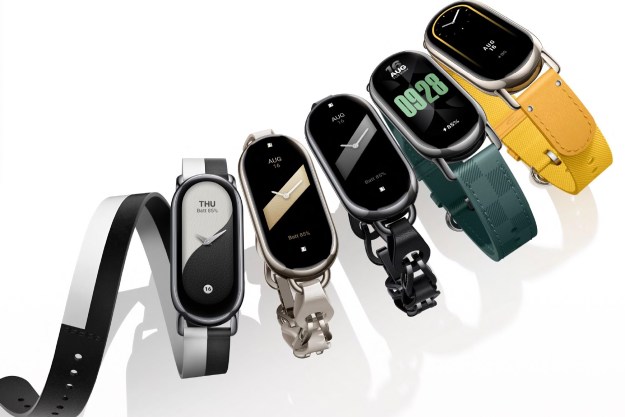Mark Weiser, the late chief technologist for the legendary Silicon Valley research lab Xerox PARC, once wrote that the most profound technologies are those that disappear, “weaving themselves into the fabric of everyday life until they are indistinguishable from it.” There’s a chance that industrial design student Minwook Paeng’s new prototype wearable one day becomes so commonplace as to be unremarkable and, therefore, unnoticeable. But that’s a chance most gamblers would be unlikely to take.
Paeng, in short, wants to put a cyclops-like extra eye in the center of your forehead. No diminutive, smartphone front-facing camera lens “eye,” either. This is a protruding, tennis ball-sized lump of tech gadgetry, the kind of googly robot eye that might have been stitched onto a creature costume in a classic episode of 1970s-era Doctor Who. But it’s for your own good.

“These days, many people walk looking at their smartphones on the street,” Paeng, who was born in South Korea but is currently studying in the Innovation Design Engineering Master’s Program at the U.K.’s Imperial College London, told Digital Trends. “Even if there is a dangerous obstacle in front, or a car comes from behind, they don’t realize it. These people are called ‘Smombie,’ [meaning] ‘smartphone plus zombie.’”
In Korea, Paeng said, the problem has gotten so bad that traffic lights on crosswalks are now installed on the ground to tell Smombies when it’s safe to cross. Smombies is a good term, but Paeng has come up with his own: One that perfectly epitomizes this latest step in the evolution (or, in some senses, devolution) of the human race. “When I first saw this, I thought we were [becoming] ‘phono sapiens,’” he said. “And the world was changing accordingly.”
Rise of the smartphone zombies
This is where the “third eye” project comes into play. Because humans seem incapable of taking their eyes off their phones while walking, Paeng has created a wearable device that keeps one, somewhat bulbous, eye on where people are supposed to be walking. Powered by Arduino, and kitted out with a gyro sensor that measures when a person is tilting their head and adjusts accordingly, the ultrasonic sensor is able to detect when an obstacle appears in front of the walker and then buzzes them to say as much.

While it could potentially be attached to a headband or a hat (you know, because that would totally make it inconspicuous!), Paeng has opted to showcase the technology by affixing it using a thin gel pad to wearers’ foreheads.
To be clear, Paeng sees this work as more a piece of conceptual art — or, perhaps, a warning — rather than an actual product. “Through this critical and ironic design project, The Third Eye, I aim to point out what we were doing with our smartphones and reflect on ourselves,” he said.
But while, as noted, the chances of this becoming a “must-have” gadget — even if it was one day brought to market — are slim, the underlying message certainly isn’t overly exaggerated. Smartphones have been linked to bad posture, with “text neck” or “turtle neck syndrome” an observable trait from those who lean forward for prolonged periods of time.

Other changes are less physically evident, but nonetheless profound. For example, the question of whether extended use of devices is linked with mental health issues is still up for debate. But the way that mobile technology has impacted behavior can be seen from surveying just about any group setting in which people are physically together, but disconnected, as they stare at their respective tiny glowing screens. According to one study, the average U.S. adult spends 3 hours and 43 minutes per day on their mobile devices. Another report suggests we check our phones an average of 58 times per day. Perhaps we all need an extra eye looking out for us.
The digital detox we need?
“Recently, many idea products for digital detox [have been] released,” Paeng said. “However, I don’t think this problem can be solved easily because smartphones have penetrated deeply into modern people’s lives. The biggest problem with this is that people can’t realize themselves that they are addicted to smartphones. We can only start by focusing on realizing and defining the problem itself before solving it. That’s why I made The Third Eye.”
As AR smart glasses and other technologies further “augment” the real world with contextual overlays and notifications, this scene could become even more blurred. In other words, while Paeng’s project is quasi-satirical in nature, a tool like this could be useful as a reminder of how long we spend gazing at screens.
So how well does it work? “It works well, but there are many obstacles in the real world [when it comes to the] street, so for effective usability, the product needs to be developed further,” he said. “It should be able to better detect obstacles and alert users in ways other than sound. I’m trying to develop it further.”
Editors' Recommendations
- Nomad’s new iPhone case and Apple Watch band may be its coolest yet
- Want to design your own smartphone? Thanks to Nothing, now you can
- No, the Journal app on your iPhone isn’t spying on you
- If you have one of these apps on your Android phone, delete it immediately
- 10 awesome things you can do with the iPhone 15 Pro Action button

